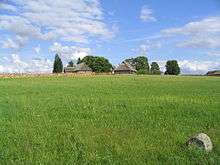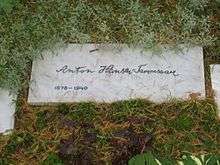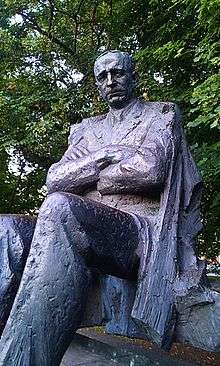Anton Hansen Tammsaare
| Anton Hansen Tammsaare | |
|---|---|
 | |
| Born |
Anton Hansen 30 January 1878 Vetepere, Estonia |
| Died |
1 March 1940 (aged 62) Tallinn, Estonia |
| Other names | A. H. Tammsaare |
| Occupation | Author |
| Years active | 1900–1940 |
Anton Hansen Tammsaare (also known as A. H. Tammsaare; born Anton Hansen 30 January 1878 – 1 March 1940), was an Estonian writer whose pentalogy Truth and Justice (Tõde ja õigus; 1926–1933) is considered one of the major works of Estonian literature and "The Estonian Novel".[1]
Biography


Tammsaare was born in Järvamaa, in the municipality of Albu, village of Vetepere, the son of a farmer. He came from a poor background, but managed to collect enough money for his education. More so his family was quite enlightened for the time, with his father for instance ordering newspapers, which most Estonian farmers didn't. He studied in Väike-Maarja and Tartu in Hugo Treffner's Gymnasium, and afterwards at the University of Tartu, where he studied law. Tammsaare's studies were interrupted by tuberculosis in 1911. He spent over a year in a sanatorium in Sochi — where his memorial house is open to the public — and the following six years in his brother's farm in Koitjärve, Estonia (now part of Põhja-Kõrvemaa Nature Reserve), reading works of Cervantes, Shakespeare and Homer. His younger sister, Maria Hansen, was the mother of Tammaare's nephew, actor Arno Suurorg.
In 1918, when Estonia became independent, Tammsaare moved to Tallinn. It was here that Tammsaare wrote those prose works, based on the history and lives of the Estonian people, which have gained him a prominent place in Estonian literature.
Tammsaare was interested in philosophy and psychology. His novels reflect the ideas of Bergson, Jung and Freud . He was, however, sceptical about cosmopolitanism. “European culture”, he wrote “is something to be overcome if one wishes to see the triumph of love, justice and humanity spoken of so glibly.” He believed (like C.R. Jakobson and Jaan Tõnnison's 'Tartu Renaissance' group) that Estonian culture was best served by farmers and intellectuals from rural backgrounds. His work was influenced( at various stages) by Oscar Wilde, Knut Hamsun and André Gide, but, above all, by the Russian realists. “In the whole of world literature," said Tammsaare, I have never read anything to compare to the Russians … there is no one to compare to Tolstoy, Dostoievsky or Gogol" … Dostoievsky “really disturbed me: I lived in a waking dream under his influence. I was especially gripped by Crime and punishment (reference: A.H Tammsaare. L. Siimisker, A.Palm. Eesti Rammat. Tallinn 1978. P:64)
Bibliography

Tammsaare's early works are characterized by rural "poetic" realism. Some of his stories also reflect the atmosphere of the revolutionary year of 1905. During what is sometimes classified as his second period, from 1908 to 1919, he wrote several short urban novels and collections of miniatures. In "Poiss ja liblik" (1915, The Boy and the Butterfly), Tammsaare shows the influence of Oscar Wilde. Internationally best known is his last novel, Devil with a False Passport.
Truth and Justice comprises five volumes, which have no individual titles (some were added in translation). Since vol. 3 contains a description about the Russian Revolution of 1905, which is not informed by ideology but by an existential attention to individual suffering, it was often combined with vol. 2 by Soviet censorship.
Even today, the third volume is sometimes called "artistically inferior", although the description of the revolution is on par with similar scenes in Pasternak's Doctor Zhivago. In Estonia, the second volume, with its Tartu educational scenes, is today probably the most enjoyed. International critics would probably opt for vol. 1 as the strongest overall; it is a classical peasant novel reminiscent of Hamsun which is also generally held to be the most telling one about "the Estonian character", embodied especially in two antagonistic farmer figures Andres and Pearu. Tammsaare himself said later that the different volumes deal with the relation of Man (i.e., the human person) to (1) the land, (2) God, (3) State and society, (4) him- or herself and (5) resignation.
Truth and Justice was not translated into English until 2014, when Haute Culture Books published the first volume of the saga under the name "Andres and Pearu". There are two complete translations into German and one each into French, Latvian, and Czech. Volume 1 has also been translated into Finnish, Polish, and Hungarian (with the title, Orcad veritekevel).
Selected works

- Kaks paari ja üksainus, 1902 - Two Pairs and the One
- Vanad ja noored, 1903 - Olds and Youngs
- Raha-auk, 1907 - The Money-Hole
- Uurimisel, 1907 - Be in Prospect
- Pikad sammud, 1908 - Long Steps
- Üle piiri, 1910 - Over the Border
- Noored hinged, 1909 - Young Spirits
- Poiss ja liblik, 1915 - The Boy and the Butterfly
- Keelest ja luulest, 1915 - About Language and Poetry
- Kärbes, 1917 - The Fly
- Varjundid, 1917 - The Shapes of the Shadows
- Sõjamõtted, 1919 - Thoughts of War
- Juudit, 1921 - Judith
- Kõrboja peremees, 1922 - The Master of the Kõrboja
- Pöialpoiss, 1923 - The Midget
- Sic Transit, 1924
- Tõde ja õigus I-V, 1926-33 - Truth and Justice, Vol.1-5
- Meie rebane, 1932 - Our Fox
- Elu ja armastus, 1934 - The Life and the Love
- Ma armastasin sakslast, 1935 - I Loved a German
- Kuningal on külm, 1936 - The King Is Cold
- Hiina ja hiinlane, 1938 - China and a Chinese
- Põrgupõhja uus Vanapagan, 1939 - The Misadventures of the New Satan (or: Devil with a False Passport or: The New Devil of Hellsbottom (the latter being a literal translation from Estonian))
- Miniatures, 1977
- Kogutud teosed, 1977-1993 (18 vols.) - Collected Works
References
- ↑ A.H Tammsaare. L. Siimisker, A.Palm. Eesti Rammat. Tallinn 1978. P:64
External links
| Wikisource has original works written by or about: Anton Hansen Tammsaare |
- Who is A.H.Tammsaare?
- Tammsaare Museum in Kadriorg
- Central bank website - shows the 25-Kroon banknote, with its depiction of Tammsaare and his farm
- A.H.Tammsaare tee - street in Tallinn named after A.H.Tammsaare